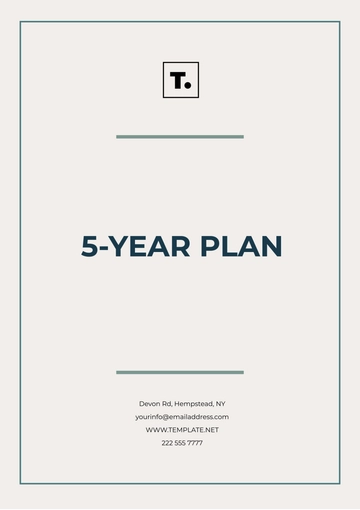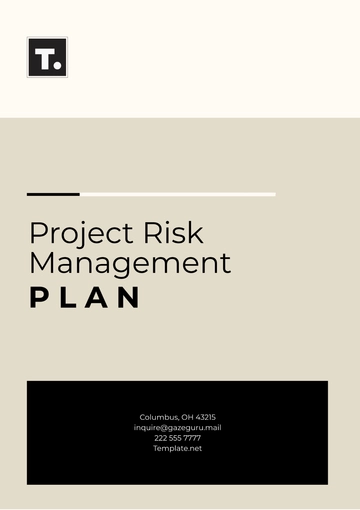Free Basic Plan

I. Introduction
In this section, provide an overview of the [Plan Details/Objectives] for [Your Company Name]. Briefly explain the purpose of the plan and what it aims to achieve. Highlight key stakeholders involved and the timeline for implementation.
Key Points
[Plan Details/Objectives]: Describe the main goals and objectives of the plan.
Stakeholders: Identify the individuals or groups who will be impacted by or involved in the [Your Company Name]'s execution.
Timeline: Outline the schedule for implementing the plan and achieving its objectives.
II. Analysis and Assessment
Conduct a thorough analysis of the current situation relevant to the [Plan Details/Objectives]. This may include a SWOT analysis, market research, or other assessment methods. Identify strengths, weaknesses, opportunities, and threats that may impact the success of the plan.
Key Components
SWOT Analysis
Strengths: Identify internal factors that contribute positively to achieving the objectives.
Weaknesses: Highlight internal factors that may hinder progress or pose challenges.
Opportunities: Explore external factors that could be leveraged to benefit the plan's objectives.
Threats: Identify external factors that may pose risks or obstacles to the plan's success.
Market Research
Target Audience: Define the demographics and characteristics of the audience targeted by the plan.
Competitor Analysis: Evaluate competitors' strategies, strengths, and weaknesses to inform your approach.
Trends: Identify industry trends and market dynamics that may impact the plan's implementation.
III. Strategy and Planning
Outline the strategy and action plan for achieving the [Plan Details/Objectives]. Define specific tactics, activities, and resources required to execute the plan effectively. Establish measurable goals and milestones to track progress.
Strategic Components
Goals and Objectives: Define clear, measurable objectives that align with the overall plan.
Action Plan: Detail the specific steps and activities needed to accomplish each objective.
Resource Allocation: Identify the resources, budget, and personnel required for plan implementation.
Timeline: Establish a timeline with deadlines for each action item and milestone.
IV. Implementation
Describe how the plan will be implemented in practice. Assign responsibilities to team members or departments involved in executing the plan. Provide guidelines for monitoring progress and making adjustments as needed.
Implementation Guidelines
Roles and Responsibilities: Clearly define the roles of individuals or teams responsible for executing each aspect of the plan.
Communication Plan: Outline how information will be communicated among team members, stakeholders, and other relevant parties.
Monitoring and Evaluation: Establish mechanisms for tracking progress, evaluating performance, and identifying areas for improvement.
Flexibility: Anticipate potential challenges or changes and develop strategies for adapting the plan accordingly.
V. Evaluation and Review
Detail how the plan's effectiveness will be evaluated and reviewed. Define key performance indicators (KPIs) and metrics for measuring success. Schedule regular reviews to assess progress and make adjustments as necessary.
Evaluation Process
KPIs: Identify specific metrics that will be used to measure the plan's success.
Data Collection: Determine how data will be collected, analyzed, and interpreted to evaluate performance.
Review Schedule: Establish a schedule for conducting regular reviews to assess progress and address any issues or challenges.
Continuous Improvement: Emphasize the importance of ongoing evaluation and refinement to ensure the plan remains effective over time.
VI. Conclusion
Summarize the key points of the plan and reiterate its importance in achieving the [Plan Details/Objectives]. Encourage stakeholders to remain committed to the plan's implementation and emphasize the potential benefits of successful execution.
Final Thoughts
Commitment: Reinforce the importance of stakeholder commitment and collaboration in realizing the plan's objectives.
Future Outlook: Highlight the potential impact of the plan's success on future opportunities and organizational growth.
Next Steps: Provide guidance on what steps should be taken next to begin implementing the plan effectively.
- 100% Customizable, free editor
- Access 1 Million+ Templates, photo’s & graphics
- Download or share as a template
- Click and replace photos, graphics, text, backgrounds
- Resize, crop, AI write & more
- Access advanced editor
You may also like
- Finance Plan
- Construction Plan
- Sales Plan
- Development Plan
- Career Plan
- Budget Plan
- HR Plan
- Education Plan
- Transition Plan
- Work Plan
- Training Plan
- Communication Plan
- Operation Plan
- Health And Safety Plan
- Strategy Plan
- Professional Development Plan
- Advertising Plan
- Risk Management Plan
- Restaurant Plan
- School Plan
- Nursing Home Patient Care Plan
- Nursing Care Plan
- Plan Event
- Startup Plan
- Social Media Plan
- Staffing Plan
- Annual Plan
- Content Plan
- Payment Plan
- Implementation Plan
- Hotel Plan
- Workout Plan
- Accounting Plan
- Campaign Plan
- Essay Plan
- 30 60 90 Day Plan
- Research Plan
- Recruitment Plan
- 90 Day Plan
- Quarterly Plan
- Emergency Plan
- 5 Year Plan
- Gym Plan
- Personal Plan
- IT and Software Plan
- Treatment Plan
- Real Estate Plan
- Law Firm Plan
- Healthcare Plan
- Improvement Plan
- Media Plan
- 5 Year Business Plan
- Learning Plan
- Marketing Campaign Plan
- Travel Agency Plan
- Cleaning Services Plan
- Interior Design Plan
- Performance Plan
- PR Plan
- Birth Plan
- Life Plan
- SEO Plan
- Disaster Recovery Plan
- Continuity Plan
- Launch Plan
- Legal Plan
- Behavior Plan
- Performance Improvement Plan
- Salon Plan
- Security Plan
- Security Management Plan
- Employee Development Plan
- Quality Plan
- Service Improvement Plan
- Growth Plan
- Incident Response Plan
- Basketball Plan
- Emergency Action Plan
- Product Launch Plan
- Spa Plan
- Employee Training Plan
- Data Analysis Plan
- Employee Action Plan
- Territory Plan
- Audit Plan
- Classroom Plan
- Activity Plan
- Parenting Plan
- Care Plan
- Project Execution Plan
- Exercise Plan
- Internship Plan
- Software Development Plan
- Continuous Improvement Plan
- Leave Plan
- 90 Day Sales Plan
- Advertising Agency Plan
- Employee Transition Plan
- Smart Action Plan
- Workplace Safety Plan
- Behavior Change Plan
- Contingency Plan
- Continuity of Operations Plan
- Health Plan
- Quality Control Plan
- Self Plan
- Sports Development Plan
- Change Management Plan
- Ecommerce Plan
- Personal Financial Plan
- Process Improvement Plan
- 30-60-90 Day Sales Plan
- Crisis Management Plan
- Engagement Plan
- Execution Plan
- Pandemic Plan
- Quality Assurance Plan
- Service Continuity Plan
- Agile Project Plan
- Fundraising Plan
- Job Transition Plan
- Asset Maintenance Plan
- Maintenance Plan
- Software Test Plan
- Staff Training and Development Plan
- 3 Year Plan
- Brand Activation Plan
- Release Plan
- Resource Plan
- Risk Mitigation Plan
- Teacher Plan
- 30 60 90 Day Plan for New Manager
- Food Safety Plan
- Food Truck Plan
- Hiring Plan
- Quality Management Plan
- Wellness Plan
- Behavior Intervention Plan
- Bonus Plan
- Investment Plan
- Maternity Leave Plan
- Pandemic Response Plan
- Succession Planning
- Coaching Plan
- Configuration Management Plan
- Remote Work Plan
- Self Care Plan
- Teaching Plan
- 100-Day Plan
- HACCP Plan
- Student Plan
- Sustainability Plan
- 30 60 90 Day Plan for Interview
- Access Plan
- Site Specific Safety Plan





























